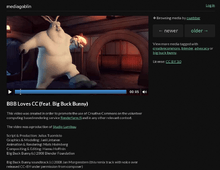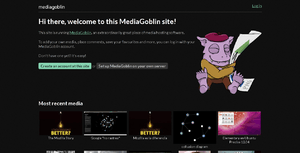MediaGoblin
|
| |
|
Homepage of a MediaGoblin-based site | |
| Developer(s) | GNU Project[1][2] |
|---|---|
| Initial release | 2 June 2011 |
| Stable release | 0.9.0[3] (March 26, 2016) [±] |
| Repository |
git |
| Development status | Active |
| Written in | Python, SQL |
| Platform | GNU/Linux,[4] Mac OS X,[4] Microsoft Windows[4] |
| Available in | English, Spanish, German, Dutch, Esperanto, Polish, Russian, Chinese, Slovak, Romanian[5] |
| Type | Web server, media hosting and sharing |
| License | AGPLv3[6] and CC0 |
| Website |
www |
GNU MediaGoblin (also shortened to MediaGoblin or GMG) is a free, decentralized Web platform (server software) for hosting and sharing many forms of digital media.[7][8] It strives to provide an extensible, federated, and freedom-respectful software replacement to major media publishing services such as Flickr, DeviantArt, and YouTube.[9][10]
History
The origins of GNU MediaGoblin date back to 2008, when a gathering was held at the Free Software Foundation in order to discuss the path that Internet communities should take. The answer was that restrictive and centralized structures were both technically and ethically doubtful, and may harm the typical fairness and availability of the Internet.[8] Since then, a number of projects have appeared to prevent this; including Identi.ca, Libre.fm, Diaspora, among others.
The coding of MediaGoblin started in March 2011,[11] still being under active development.
- 2012-08-24 – version 0.3.1 released, with theming support
- From October 2012 to 9 November, the project launched a crowdfunding campaign through the Free Software Foundation.[12][13][14]
- 2012-12-20 – version 0.3.2 released, with support for 3D models, collections, and API.
- 2013-03-12 – version 0.3.3 released, with interface and API enhancements, and avoiding unneeded processing of some videos.
- 2013-06-17 – version 0.4.0 released. New plugin system, support for PDF and Open Document Format through PDF.js and LibreOffice respectively. Experimental implementation of the Piwigo API.[15]
- 2013-09-05 – version 0.5.0 released, with a pluggable authentication system (including OpenID and Mozilla Persona), pluggable media handling and comment notifications.
- 2013-12-03 – version 0.6.0 released, web-based administration for user permissions, media complaint handling, non-interactive uploads, authentication via LDAP and user-specific Disk quota.
- 2014-08-26 – version 0.7.0 released, base Pump.io API implemented, incorporated Skeleton for a more responsive layout, introduced the Sandy Seventies Speedboat theme, command line batch uploading, experimental 'blog' media type and a metadata plugin.[16]
- 2015-06-04 – version 0.8.0 released, client to server API improved[17]
- 2016-03-26 – version 0.9.0 released, Python 3 support (supports Python 2.7, Python 3.4 or later). Improved OAuth security. Internal improvements for federation (improved database layout and particularly in permitting generic relations, comments, etc.). Improved the way collections are handled. Bugfixes.[18]
Design and features
MediaGoblin is part of GNU,[1] and its code is released under the terms of the GNU Affero General Public License;[6] meaning that it adheres to the principles of free and open-source software. The copyright on everything else (e.g. design, logo) is given to the public domain. Christopher Allan Webber, the core developer, came up with the name "MediaGoblin" which also makes a pun with the pronunciation of "gobbling".[19] The project mascot is a purple goblin called Gavroche wearing clothing that resembles a stereotypical artist costume.[20]
The main page displays an upper banner with MediaGoblin's typeface and an authentication section for users. The remaining space is left to show thumbnails of the latest posted works. Each user owns a personal profile comprised by two vertical sections – one for uploads arranged as a gallery and another with a customizable text box. For displaying media, the platform focuses on the work itself rather than overstocking with options and buttons; nonetheless, comments can be added under the artwork description. Some other features like tags, metadata, theming, Creative Commons licensing and GPS support can be enabled as separate plug-ins to enrich the usage of GNU MediaGoblin.[21]

The platform successfully hosts and displays many sorts of media:
- As of version 0.3.1 it includes support for plain text (ASCII art), images (PNG and JPEG).
- HTML5 capabilities are widely used to play video and/or audio contained in WebM format; while FLAC, WAV and MP3 uploads are automatically transcoded to Vorbis audio and then encapsulated into WebM.[22]
- 3D models support (preview and renderization) was added on 22 October 2012 and is achieved by means of HTML5 Canvas, Thingiview, WebGL and Blender.[23][24]
See also
References
- 1 2 "About GNU MediaGoblin — GNU MediaGoblin unknown documentation". Docs.mediagoblin.org. Retrieved 2015-04-01.
- ↑ "Mediagoblin homepage". Gnu.org. Retrieved 2015-04-01.
- ↑ Deb Nicholson (29 March 2016). "MediaGoblin 0.9.0: The Three Goblineers". MediaGoblin Team. Retrieved 29 March 2016.
- 1 2 3 "MediaGoblin Wiki". MediaGoblin Team. Retrieved 4 March 2012.
- ↑ "GNU MediaGoblin localization - Transifex - Gitorious". Transifex.net. Retrieved 2015-04-01.
- 1 2 "GNU MediaGoblin - Gitorious". Gitorious.org. Retrieved 2015-04-01.
- ↑ "FSF Directory". Free Software Foundation. Retrieved 29 February 2012.
- 1 2 "MediaGoblin documentation". GNU MediaGoblin. Retrieved 5 March 2012.
- ↑ "MediaGoblin". GNU MediaGoblin. Retrieved 5 March 2012.
- ↑ "Mediagoblin, el próximo gran proyecto GNU". Alt1040.com. Retrieved 2015-04-01.
- ↑ "Version 0.1.0 - Living the Dream". GNU MediaGoblin. Retrieved 6 March 2012.
- ↑ Bruce Byfield (2012). "MediaGoblin: Saving the Internet Through Federation". Linux Magazine Online. Retrieved 18 October 2012.
- ↑ "FSF rallies support for GNU MediaGoblin to make media publishing free "as in freedom"" (Press release). Free Software Foundation. 2012-10-11. Retrieved 2012-10-17.
- ↑ "Support". MediaGoblin.org. 1999-02-22. Retrieved 2015-04-01.
- ↑ "MediaGoblin 0.4.0 adds document support". The H Open. 18 June 2013. Archived from the original on 26 June 2013. Retrieved 25 June 2013.
- ↑ "MediaGoblin 0.7.0: Time Traveler's Delight" (Press release). 2014-08-26.
- ↑ "MediaGoblin 0.8.0: A Gallery of Fine Creatures" (Press release). 2015-06-04.
- ↑ "MediaGoblin 0.9.0: The Three Goblineers" (Press release). 2016-03-26.
- ↑ "Original Design Decisions". MediaGoblin. Retrieved 25 April 2014.
- ↑ "Free Software Supporter, Issue 57, December 2012". Free Software Foundation. 7 December 2012. Retrieved 2 January 2012.
- ↑ "Take the tour! Here's what MediaGoblin offers- Living the Dream". GNU MediaGoblin. Retrieved 6 March 2012.
- ↑ "MediaGoblin 0.3.0: Rise of the RoboGoblins". GNU MediaGoblin. 1 March 2012. Retrieved 26 October 2012.
- ↑ "MediaGoblin now with 3d support: MediaGoblin community and Lulzbot team up". GNU MediaGoblin. 22 October 2012. Retrieved 26 October 2012.
- ↑ "Media Types — GNU MediaGoblin unknown documentation". Docs.mediagoblin.org. Retrieved 2015-04-01.
External links
| Wikimedia Commons has media related to GNU MediaGoblin. |
